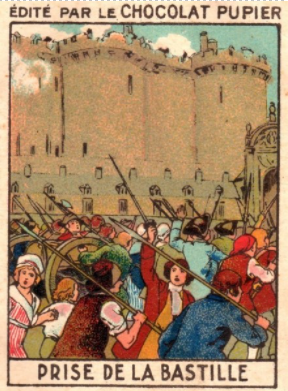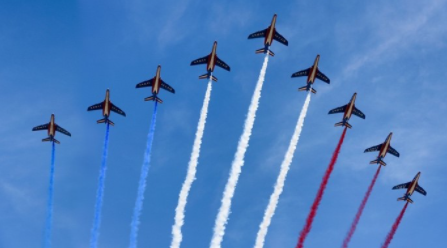16.3: Le 14 juillet
- Page ID
- 135047
\( \newcommand{\vecs}[1]{\overset { \scriptstyle \rightharpoonup} {\mathbf{#1}} } \)
\( \newcommand{\vecd}[1]{\overset{-\!-\!\rightharpoonup}{\vphantom{a}\smash {#1}}} \)
\( \newcommand{\id}{\mathrm{id}}\) \( \newcommand{\Span}{\mathrm{span}}\)
( \newcommand{\kernel}{\mathrm{null}\,}\) \( \newcommand{\range}{\mathrm{range}\,}\)
\( \newcommand{\RealPart}{\mathrm{Re}}\) \( \newcommand{\ImaginaryPart}{\mathrm{Im}}\)
\( \newcommand{\Argument}{\mathrm{Arg}}\) \( \newcommand{\norm}[1]{\| #1 \|}\)
\( \newcommand{\inner}[2]{\langle #1, #2 \rangle}\)
\( \newcommand{\Span}{\mathrm{span}}\)
\( \newcommand{\id}{\mathrm{id}}\)
\( \newcommand{\Span}{\mathrm{span}}\)
\( \newcommand{\kernel}{\mathrm{null}\,}\)
\( \newcommand{\range}{\mathrm{range}\,}\)
\( \newcommand{\RealPart}{\mathrm{Re}}\)
\( \newcommand{\ImaginaryPart}{\mathrm{Im}}\)
\( \newcommand{\Argument}{\mathrm{Arg}}\)
\( \newcommand{\norm}[1]{\| #1 \|}\)
\( \newcommand{\inner}[2]{\langle #1, #2 \rangle}\)
\( \newcommand{\Span}{\mathrm{span}}\) \( \newcommand{\AA}{\unicode[.8,0]{x212B}}\)
\( \newcommand{\vectorA}[1]{\vec{#1}} % arrow\)
\( \newcommand{\vectorAt}[1]{\vec{\text{#1}}} % arrow\)
\( \newcommand{\vectorB}[1]{\overset { \scriptstyle \rightharpoonup} {\mathbf{#1}} } \)
\( \newcommand{\vectorC}[1]{\textbf{#1}} \)
\( \newcommand{\vectorD}[1]{\overrightarrow{#1}} \)
\( \newcommand{\vectorDt}[1]{\overrightarrow{\text{#1}}} \)
\( \newcommand{\vectE}[1]{\overset{-\!-\!\rightharpoonup}{\vphantom{a}\smash{\mathbf {#1}}}} \)
\( \newcommand{\vecs}[1]{\overset { \scriptstyle \rightharpoonup} {\mathbf{#1}} } \)
\( \newcommand{\vecd}[1]{\overset{-\!-\!\rightharpoonup}{\vphantom{a}\smash {#1}}} \)
\(\newcommand{\avec}{\mathbf a}\) \(\newcommand{\bvec}{\mathbf b}\) \(\newcommand{\cvec}{\mathbf c}\) \(\newcommand{\dvec}{\mathbf d}\) \(\newcommand{\dtil}{\widetilde{\mathbf d}}\) \(\newcommand{\evec}{\mathbf e}\) \(\newcommand{\fvec}{\mathbf f}\) \(\newcommand{\nvec}{\mathbf n}\) \(\newcommand{\pvec}{\mathbf p}\) \(\newcommand{\qvec}{\mathbf q}\) \(\newcommand{\svec}{\mathbf s}\) \(\newcommand{\tvec}{\mathbf t}\) \(\newcommand{\uvec}{\mathbf u}\) \(\newcommand{\vvec}{\mathbf v}\) \(\newcommand{\wvec}{\mathbf w}\) \(\newcommand{\xvec}{\mathbf x}\) \(\newcommand{\yvec}{\mathbf y}\) \(\newcommand{\zvec}{\mathbf z}\) \(\newcommand{\rvec}{\mathbf r}\) \(\newcommand{\mvec}{\mathbf m}\) \(\newcommand{\zerovec}{\mathbf 0}\) \(\newcommand{\onevec}{\mathbf 1}\) \(\newcommand{\real}{\mathbb R}\) \(\newcommand{\twovec}[2]{\left[\begin{array}{r}#1 \\ #2 \end{array}\right]}\) \(\newcommand{\ctwovec}[2]{\left[\begin{array}{c}#1 \\ #2 \end{array}\right]}\) \(\newcommand{\threevec}[3]{\left[\begin{array}{r}#1 \\ #2 \\ #3 \end{array}\right]}\) \(\newcommand{\cthreevec}[3]{\left[\begin{array}{c}#1 \\ #2 \\ #3 \end{array}\right]}\) \(\newcommand{\fourvec}[4]{\left[\begin{array}{r}#1 \\ #2 \\ #3 \\ #4 \end{array}\right]}\) \(\newcommand{\cfourvec}[4]{\left[\begin{array}{c}#1 \\ #2 \\ #3 \\ #4 \end{array}\right]}\) \(\newcommand{\fivevec}[5]{\left[\begin{array}{r}#1 \\ #2 \\ #3 \\ #4 \\ #5 \\ \end{array}\right]}\) \(\newcommand{\cfivevec}[5]{\left[\begin{array}{c}#1 \\ #2 \\ #3 \\ #4 \\ #5 \\ \end{array}\right]}\) \(\newcommand{\mattwo}[4]{\left[\begin{array}{rr}#1 \amp #2 \\ #3 \amp #4 \\ \end{array}\right]}\) \(\newcommand{\laspan}[1]{\text{Span}\{#1\}}\) \(\newcommand{\bcal}{\cal B}\) \(\newcommand{\ccal}{\cal C}\) \(\newcommand{\scal}{\cal S}\) \(\newcommand{\wcal}{\cal W}\) \(\newcommand{\ecal}{\cal E}\) \(\newcommand{\coords}[2]{\left\{#1\right\}_{#2}}\) \(\newcommand{\gray}[1]{\color{gray}{#1}}\) \(\newcommand{\lgray}[1]{\color{lightgray}{#1}}\) \(\newcommand{\rank}{\operatorname{rank}}\) \(\newcommand{\row}{\text{Row}}\) \(\newcommand{\col}{\text{Col}}\) \(\renewcommand{\row}{\text{Row}}\) \(\newcommand{\nul}{\text{Nul}}\) \(\newcommand{\var}{\text{Var}}\) \(\newcommand{\corr}{\text{corr}}\) \(\newcommand{\len}[1]{\left|#1\right|}\) \(\newcommand{\bbar}{\overline{\bvec}}\) \(\newcommand{\bhat}{\widehat{\bvec}}\) \(\newcommand{\bperp}{\bvec^\perp}\) \(\newcommand{\xhat}{\widehat{\xvec}}\) \(\newcommand{\vhat}{\widehat{\vvec}}\) \(\newcommand{\uhat}{\widehat{\uvec}}\) \(\newcommand{\what}{\widehat{\wvec}}\) \(\newcommand{\Sighat}{\widehat{\Sigma}}\) \(\newcommand{\lt}{<}\) \(\newcommand{\gt}{>}\) \(\newcommand{\amp}{&}\) \(\definecolor{fillinmathshade}{gray}{0.9}\)In this section, you will learn about the 14th of July celebration in France
On étudie !
La Prise de la Bastille en 1789

Les avions militaires survolent le défilé aux Champs-Élysées

Lecture - Le 14 juillet
La Fête du 14 juillet commémore l’anniversaire de la prise de la Bastille en 1789. Elle est devenue fête nationale en 1880.
Le drapeau bleu, blanc et rouge — le « tricolore » — a été créé en 1794 pendant la Révolution française et sert d’emblème de la Ve (5e) République. Le blanc est la couleur des rois. Le bleu et le rouge sont les couleurs de Paris.
La devise de la République française est : « Liberté, égalité, fraternité ». Elle est née de la Révolution de 1789, et est devenue la devise officielle de la République en 1848.
Le coq, symbole d’origine gauloise, est devenu l’emblème de la République française. Ce symbole provient de la similarité en langue latine entre « gallus » qui voulait dire coq et « Gallus » qui voulait dire Gaulois.
La Marseillaise est l’hymne national de la France. Elle a été composée par Claude Joseph Rouget de Lisle en 1792 pour les soldats français. Le titre original de cette chanson était « Chant de guerre pour l'Armée du Rhin ». C’est pour cette raison que les paroles sont si guerrières. La Convention nationale française l'a adoptée comme l'hymne de la République en 1795. Elle a acquis son titre actuel (« La Marseillaise ») parce qu’elle a d'abord été chantée dans les rues de Paris par des bénévoles marseillais.
Les bals des pompiers sont des soirées nocturnes organisées dans les casernes des pompiers des 20 arrondissements de Paris et de la région Île-de-France. Ces fêtes conviviales commencent vers 21 heures et se poursuivent jusqu'au petit matin, amassant souvent de longues files d'attente de locaux désireux de se joindre à la fête.
Voir les paroles de la Marseillaise.
Regardez cette scène du film Casablanca où ils chantent La Marseillaise.
Voici quelques vidéos sur :
On pratique !
Activité A
Compréhension - vrai ou faux
- Les bals des pompiers sont célébrés dans 19 des 20 arrondissements de Paris.
- Avant, la Marseillaise s’appelait « Chant de guerre de l’Armée de Rhin ».
- La Marseillaise est devenue l’hymne national après la Révolution française.
- C’est durant l’année de la révolution qu’on a officiellement choisi la devise « Liberté, égalité, fraternité. »
- Le 14 juillet est devenu fête nationale avant presque un siècle après la Révolution française.
- Les bals des pompiers commencent avant 8 heures du soir.
- Les bals des pompiers sont très populaires.
Activité B
Qu’avez-vous compris ?
- De quelle couleur est le drapeau français ?
- Quand est-ce qu’on a décidé que le drapeau français allait être tricolore ?
- Pourquoi a-t-on nommé l’hymne nationale « la Marseillaise » ?
- La devise de la France a été décidée avant ou après la révolution ?
- Pourquoi le coq est-il devenu l’emblème de la France ?
- Qu’est-ce qu’on commémore durant le 14 juillet en France ?
- Qui a composé l’hymne nationale ? Pour qui l’a-t-il composé ?
Activité C
On chante !
Écoutez La Marseillaise et étudiez les paroles. Complétez les paroles suivantes avec les mots qui manquent.
Allons enfant de la patrie.
Le jour de est arrivé.
Contre nous de la .
L' sanglant est levé
Entendez-vous dans les campagnes
ces féroces soldats
Ils viennent jusque dans vos ,
Egorger vos fils, vos compagnes
Aux citoyens ! vos bataillons !
Marchons, oui ,
Qu'un sang impur nos sillons !
On approfondit !
Use the following resources to type accents and/or search for words:
- Accents: ç, à, é, è, â, ê, î, ô, û, ù, ë, ï, ü
- Dictionnaire français-anglais


